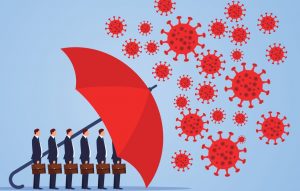Hoosier unemployment apps skyrocket to 54,000 in one week
The numbers are skyrocketing as businesses close as part of efforts to stop the spread of the coronavirus.
The numbers are skyrocketing as businesses close as part of efforts to stop the spread of the coronavirus.

“It’s your job to survive and to make sure that when these social controls are lifted and everybody starts to come back out that you’re ready for business,” IU’s Phil Powell, an economist at the Kelley School of Business, tells host Mason King.
Both the one-week rise and the total number of applications were far above the levels seen over the past year .
Details on the president’s economic rescue plan remain sparse, but its centerpiece is to dedicate $500 billion to start issuing direct payments to Americans by early next month. It would also funnel cash to businesses to help keep workers on payroll.
The growing number of people filing for unemployment checks raises fresh questions about whether states have stockpiled enough money since the last recession to tide over idled workers until the crisis ends.
The vast changes deemed necessary to defeat the virus—people and companies no longer engaging with each other—are bringing everyday business to a halt and likely delivering a death blow to the longest economic expansion on record.
Across the country, consumer spending—which supports 70% of the economy—is grinding to a halt as fears of the escalating coronavirus pandemic keep people from stores, restaurants, movie theaters and workplaces.
Markets received a bump around midday Tuesday after Vice President Mike Pence said the nation’s big health insurers would cover co-pays for coronavirus testing.
Oil prices fell Monday by the most in one day since the 1991 Gulf War. The price of U.S. crude fell as much as 34%, to $27.34 a barrel, the lowest price since early 2016. Here’s what’s driving the price drop.
Since breaking out of China, the coronavirus has had a chilling effect on companies related to manufacturing, travel and tourism, which then hampers other industries and weakens consumer confidence.
Just weeks since most economists bet the China-led slump would quickly reverse once the virus was contained, many are rethinking that optimism as swathes of Chinese factories stay shut and workers idled.
The Labor Department said Friday that the unemployment rate fell to 3.5% last month, matching a 50-year low, down from 3.6% in January.
A range of job market barometers will provide some of the most vital signals about the economy in the coming weeks and months.
The Federal Reserve’s latest nationwide survey of business conditions has found that the coronavirus outbreak has begun to affect tourism and disrupt manufacturing chains in parts of the United States.
If the disease known as COVID-19 becomes a global pandemic, economists expect the impact could be much worse, with the U.S. and other global economies falling into recession.
Orders to U.S. factories for big-ticket manufactured goods were pulled down by decreased demand for cars, auto parts and military aircraft, but the category that tracks business investment rose significantly.
Service providers and manufacturers are noting reluctance among clients to place orders amid the global virus scare.
Among the first tangible impacts in the U.S. is a decline in the number of Chinese tourists. Visitors from China represent a lucrative market for American airlines, hotels, luxury retailers and entertainment venues.
It was a slight improvement over December, as unseasonably warm weather boosted sales at hardware stores and furniture stores.
Jerome Powell told Congress on Tuesday that the Fed is monitoring developments stemming from the coronavirus, which he said “could lead to disruptions in China that spill over to the rest of the global economy.”